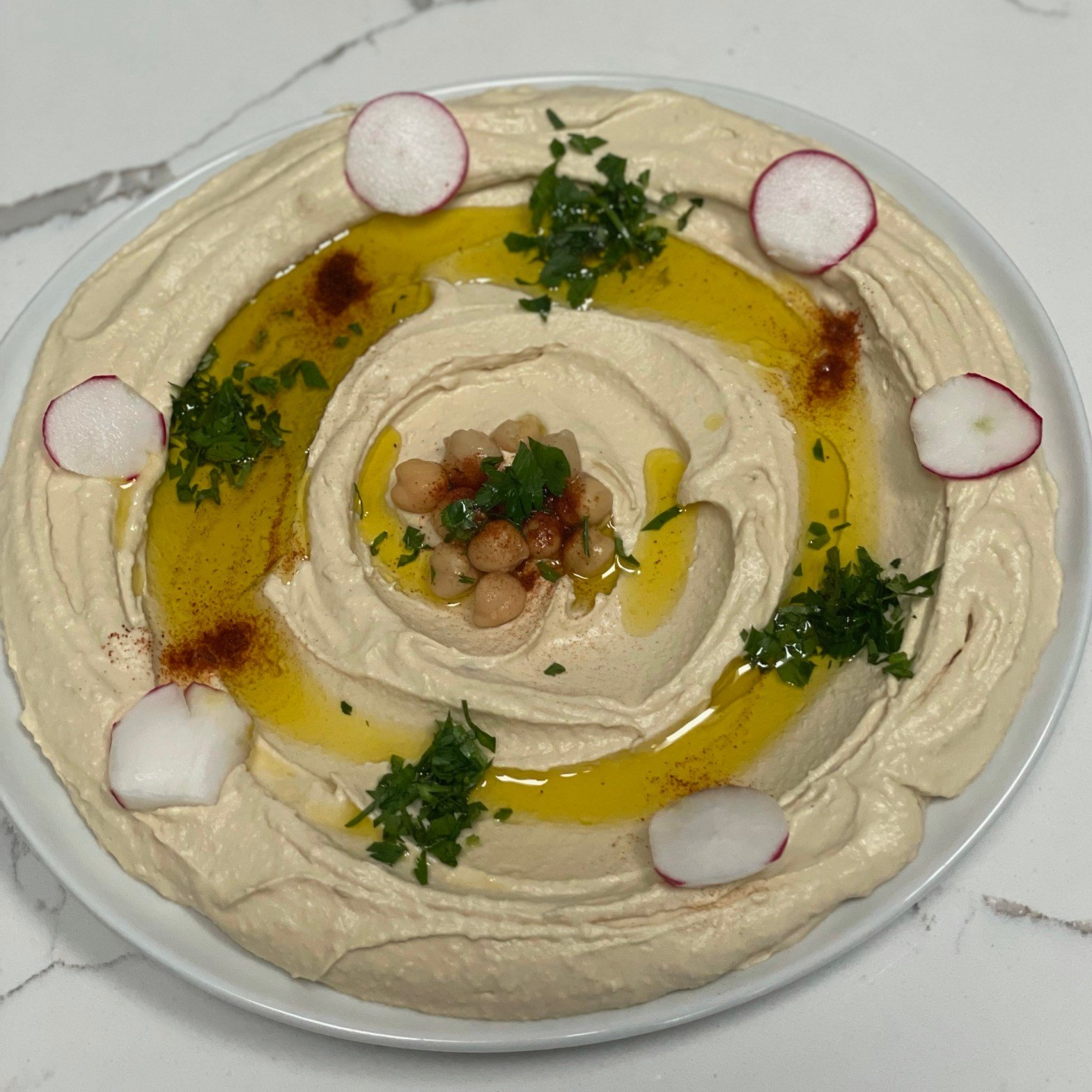Mimo’s Famous Hummus
By: Julis Huston
Serves: 5 portions
Prep Time: 12 minutes
There are moments in our lives when we taste a dish for the first time and it instantly sends our taste buds through a whirlwind. This was my experience with hummus; although I had grown up eating store-bought hummus, as soon as I tried ‘the real deal,’ I realized what I had been missing out on. Hummus is a nutrient-dense Middle Eastern dip that has been prepared for over 7,000 years, originating in Ancient Egypt (Wallace). It is a snack that is high in protein and dietary fiber, and it is also a great way to increase legume consumption (Augustin). The legume family includes beans, peas, lentils, peanuts, and soybeans, and consuming a healthy portion of these foods contributes to a balanced diet by lowering blood sugar and blood pressure. Legumes also contain powerful antioxidants to prevent cell damage and fight disease (Polak). While hummus is currently served in a variety of ways all over the world, the following recipe is as authentic as it gets; for this piece I chose to enlist the help of a true hummus master : my dear friend and neighbor Marie (Mimo) Kattan. Growing up in Lebanon, Mimo has been making hummus for over two decades, and resultantly she has figured out the secret to a deliciously classic hummus: simplicity. Rather than adding unnecessary flavors and spices, Mimo’s hummus focuses on quality and traditional ingredients. Before we jump into the recipe, I asked Mimo a few questions so you can hear from the expert herself! Continue reading below to hear us spill the (garbanzo) beans.
Could you give a short introduction about yourself?
Hello, my name is Marie Kattan and my nickname is “Mimo”. I live in Virginia Beach, Virginia, I am married with two kids, and I am originally from Lebanon.
Could you share a little bit about the cultural significance of hummus and how you learned to make it?
Hummus is very big in Lebanon; it is one of the traditional and original appetizers that is offered at every restaurant. In my house I have to have hummus in the fridge at all times—my family loves it—we snack on it with carrots and cucumber. I learned how to make hummus from my mom and dad because my dad used to make it all the time for the restaurant he owned. Everyone LOVED his hummus!
What do you think is the most important key to making traditional hummus?
I’ve been making hummus for 20+ years from scratch and I have learned that to have a delicious hummus you need to have a very good tahini and a good brand of chickpeas (I use Goya). Tahini and chickpeas play a big role in creating a traditional hummus dish.
Do you think there is value in learning how to make foods from different cultures?
I cook all the time, so I love to learn how to make different dishes from different cultures. It definitely has its value and brings opportunity to your family and friends to share with each other. I teach my friends how to make hummus all the time, and I learn how to make different dishes from them as well. I love that they want to offer my recipe to their friends and family.
Do you have a favorite memory associated with hummus?
I don’t have a specific favorite memory with hummus, but I love when I walk into a party with a hummus plate in my hand and everyone screams, Mimo is here with her delicious hummus! It makes me so happy.
Ingredients:
2 cans of Goya chickpeas rinsed and drained
Juice of 3 fresh lemons -
1 ¼ cup of tahini
¼ teaspoon of salt
Instructions:
Mix everything in the food processor , if the hummus is a little thick and it doesn’t need anymore lemon juice , you can add a little bit of water until it becomes creamy. I don’t use garlic in mine; after lots of experimenting I discovered that it tastes better without the garlic.
Transfer to a plate , decorate with some chopped parsley or olives and drizzle some olive oil on top. Bon appetit!
Reference List:
Augustin, L.S.A., Chiavaroli, L., Campbell, J. et al. Post-prandial glucose and insulin responses of hummus alone or combined with a carbohydrate food: a dose–response study. Nutr J 15, 13 (2015). https://doi.org/10.1186/s12937-016-0129-1
Polak, R., Phillips, E. M., & Campbell, A. (2015). Legumes: Health Benefits and Culinary Approaches to Increase Intake. Clinical Diabetes, 33(4), 198–205. https://doi.org/10.2337/diaclin.33.4.198
Wallace, T., Murray, R., & Zelman, K. (2016). The Nutritional Value and Health Benefits of Chickpeas and Hummus. Nutrients, 8(12), 766. doi:10.3390/nu8120766

